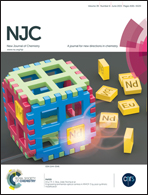Novel fluorescent probes based on rhodamine for naked-eye detection of Fe3+ and their application of imaging in living cells†
Abstract
Employing the “off-on” switching of the spirocyclic moiety in rhodamine B derivatives, two highly selective and sensitive probes for Fe3+ were prepared and confirmed by X-ray crystallography. An obvious fluorescent enhancement was observed in the presence of Fe3+, accompanied by significant color changes, which can be used for “naked-eye” detection. Moreover, confocal laser scanning microscopy experiments have proven that the probes were successfully used for fluorescence imaging in HepG2 cells.


 Please wait while we load your content...
Please wait while we load your content...